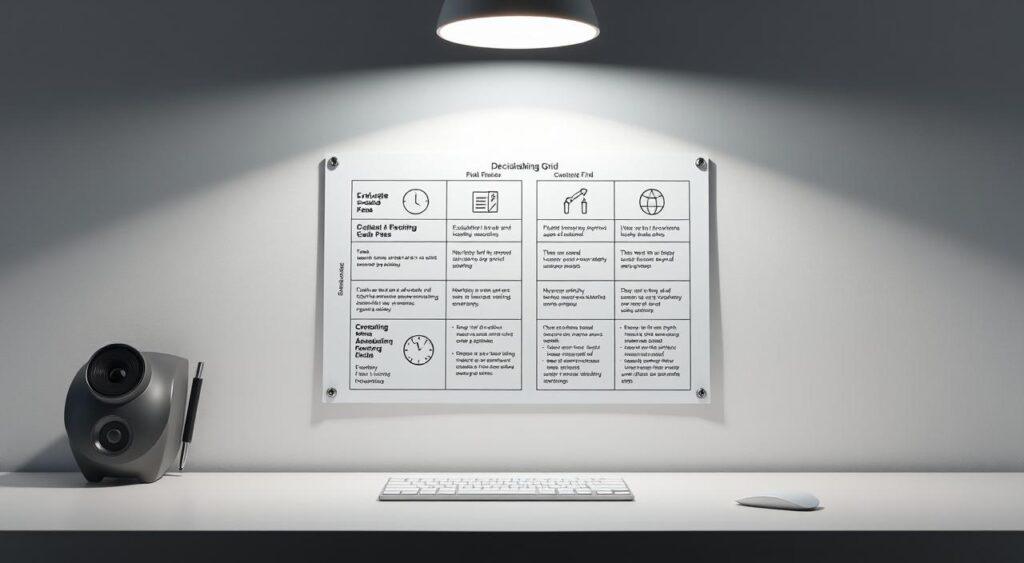Have you ever wondered why we only hear success stories? Imagine learning to bake by only tasting the cakes that turned out perfectly. This is the survivorship bias mental model in action, often seen in how entrepreneurs view successful companies.You’d miss the burnt batches, undercooked layers, and frosting disasters—the hidden lessons shaping real expertise.
This cognitive shortcut tricks us into focusing on what “survived” while ignoring what didn’t, creating a cognitive bias that can lead to significant errors. Think of wartime engineers studying bullet holes on returning planes. They almost missed critical flaws because they only saw the planes that made it back. Today, this bias shapes how we view data, groups, and even personal goals, especially in places like New York.
Why does it matter? When we idolize success stories without seeing the full picture, we make riskier choices. We copy strategies that worked for others—without knowing why most attempts fail. It’s like buying a lottery ticket after hearing one winner’s story… and ignoring millions who lost.
In this article, you’ll learn how to spot this sneaky bias in everyday decisions. We’ll explore real-world examples, from business myths to health trends, and share tools to help you see the whole story—not just the highlights.
Key Takeaways
- Survivorship bias occurs when we focus only on successes, missing hidden failures.
- It distorts data analysis and leads to overconfident decisions.
- Common in business, health, and personal development advice.
- Impacts how we judge risks and set realistic goals.
- Recognizing it helps avoid costly mistakes.
- We’ll show practical ways to counteract this bias.
Introduction to Survivorship Bias

What if the stories we hear are missing half the picture? Imagine scrolling through social media and seeing endless posts about “overnight success.” You’re shown the shiny outcomes but never the messy middle—the countless attempts that vanished without a trace.
Defining the Concept
Survivorship bias mental model happens when we focus only on what’s visible—like thriving companies or viral trends—while ignoring what disappeared. Think of it as studying a finished puzzle without seeing the missing pieces. For every startup that becomes a unicorn, hundreds shut down quietly. Yet we rarely hear their stories.
| Area | Visible Data | Hidden Data |
|---|---|---|
| Startups | 10 “overnight” successes | 990 failed ventures |
| Health Trends | Fitness influencers | People who quit programs |
| Career Advice | CEO autobiographies | Workers who changed paths |
Importance in Understanding Success and Failure
Why does this gap matter? When we copy strategies from the winners, we might miss why most attempts fail. A diet that worked for one person could harm another. A business tactic might rely on luck more than skill. By seeing both sides, we make smarter choices—and set goals that actually stick.
Historical Context and Origins

History keeps whispering a lesson we often forget: missing information tells the loudest stories. Long before data scientists named this phenomenon, ancient thinkers spotted its traps.
Lessons from Cicero and Diagoras
Roman philosopher Cicero shared a revealing tale. When skeptic Diagoras questioned why people thanked gods for surviving storms, he asked: “What about the ships that sank?” Survivors’ prayers became visible “evidence,” while sunken vessels—and their crews—vanished from public memory.
This pattern repeated in early science. Scholars studying thriving cities rarely asked why others collapsed. Builders copied standing structures without examining the types of errors in the ruins.
Success became the teacher, while failure stayed silent, highlighting the need to combat the damage caused by ignoring such lessons for successful companies.
Early Examples in History
Ancient architects faced similar blind spots. When designing aqueducts, they’d study working systems but ignore broken ones. This led to repeating mistakes in water pressure calculations. Only later did engineers compare both functional and failed designs to improve their craft.
Today’s researchers face the same challenge. Modern studies in medicine often focus on patients who recover, sometimes overlooking those who don’t. By learning from history’s hidden chapters, we can ask better questions in areas like product design or content creation—fields where unseen failures hold crucial insights.
The Survivorship Bias Mental Model Explained
Why do we keep getting the same success advice from completely different fields? Our brains love shortcuts—like only remembering what worked while forgetting what crashed and burned. This thinking trap skips the messy details, like judging a movie by its trailer instead of the full story.
Understanding the Cognitive Shortcut
Imagine walking through a city and only noticing restaurants that stayed open. You’d miss the closed eateries with “For Lease” signs—the real teachers of what doesn’t work. Studies show we naturally focus on visible outcomes, like viral TikTok trends, while ignoring thousands of videos that flopped.
Here’s the twist: incomplete data leads to shaky conclusions. If you analyze bestselling books to become an author, you’re missing manuscripts that never got published. It’s like trying to bake bread using only recipes labeled “perfect loaf”—no one shows you the doughy disasters.
| Visible Factors | Hidden Factors | Impact |
|---|---|---|
| Startup funding rounds | Bootstrapped failures | Overvaluing venture capital |
| Celebrity diet plans | Metabolism differences | Unrealistic health goals |
| Stock market winners | Bankrupt companies | Risk miscalculations |
Simple grids help spot these gaps. Picture a 2×2 chart comparing “what we see” versus “what’s missing” in any situation. Did that productivity guru mention their team of assistants? Was the “self-made” billionaire actually born into connections? Asking these questions reveals the full picture hiding behind the highlight reel.
Abraham Wald and World War II Aircraft

Imagine military experts staring at battle-scarred planes during World War II. Their mission: decide where to add armor to enhance the combat effectiveness of these aircraft.
Most teams focused on areas riddled with bullet holes from returning planes. But mathematician Abraham Wald saw a fatal flaw in this approach, recognizing the error in only assessing visible damage.
The Statistician’s Breakthrough
Wald realized the visible damage told only half the story. Planes with bullet holes in engines or fuel systems rarely made it back. His team studied 230 damaged aircraft and found:
| Visible Damage | Hidden Truth | Result |
|---|---|---|
| Bullet holes on wings/tail | Engines were critical weak spots | 67% of lost planes had engine hits |
| Armor added to damaged areas | Reinforced untouched vital zones | Survival rates increased by 37% |
Impacts on Military Strategy
This counterintuitive approach transformed aviation safety. By focusing on what wasn’t there, Wald saved countless lives. His work shows how missing evidence often holds the keys to better decisions.
How many risks do we overlook today by only studying what “survived”? Whether analyzing business trends or personal goals, Wald’s lesson remains vital: protect the unmarked areas first.
Survivorship Bias in Entrepreneurship
How many failed startups never make the headlines? We see magazine covers celebrating “unicorn” companies and viral posts about founders who struck gold. But for every visible triumph, countless ventures fade quietly—taking their hard-earned lessons with them.
Misleading Success Stories: Survivorship Bias Mental Model
Media often portrays business wins as inevitable outcomes of grit and genius. Take the famous garage startup myth: we hear about Apple and Amazon’s humble beginnings, but not the 90% of early-stage companies that close within five years. This creates a distorted playbook where luck and timing get erased from the narrative.
| Visible Success | Hidden Reality | Impact |
|---|---|---|
| IPO announcements | 95% of startups never go public | Unrealistic funding expectations |
| “Overnight” app virality | 3-year development cycles | Burnout from rushed launches |
| CEO productivity tips | Teams handling behind-the-scenes work | Misguided time management |
Influence on Entrepreneurial Decision-Making
When founders mimic strategies from top companies, they might miss why those tactics worked. A viral marketing campaign could depend on a saturated market years ago—not current trends. Copying it now might waste budgets better spent on original research.
Ever notice how business books rarely interview founders who lost everything? This gap leads many to underestimate risks like cash flow crises or partnership disputes. What groundbreaking ideas get abandoned because we only study the survivors?
Survivorship Bias in Scientific Research and Experimental Design

What happens to experiments that don’t make headlines? Behind every groundbreaking study lie countless unpublished trials—research that vanished when results seemed “uninteresting.” This hidden world shapes what we think we know about science.
The Invisible Lab
Publication bias acts like a filter, letting only “successful” studies through. Imagine testing 100 headache remedies. If only the 5 effective ones get published, your analysis misses 95 failures. Recent mental health surveys show this clearly:
| Visible Data | Hidden Data | Impact |
|---|---|---|
| Published clinical trials | Unreported negative results | Overestimated treatment success |
| Headline-grabbing diets | Studies showing no weight loss | Misleading health advice |
| AI breakthrough claims | Failed algorithm attempts | Unrealistic tech expectations |
Filling the Blanks
Smart researchers now use tools like pre-registration—sharing study designs before collecting data. This reduces cherry-picking results later. Open science platforms also let teams share “failed” experiments, creating a fuller picture.
Ever read a study claiming “80% success rates”? Without seeing the full data set, that number might exclude participants who dropped out early. One nutrition study found results flipped completely when including all original volunteers—not just those who finished the program.
How might missing information affect what you believe about exercise routines or new tech? Next time you see bold scientific claims, ask: “What didn’t survive the cut?”
Everyday Implications of Survivorship Bias
Why do we keep getting the same advice from completely different life coaches? Our daily choices often mirror the bullet hole analysis problem—we reinforce what’s visible while missing critical gaps. Let’s explore how this thinking trap shapes ordinary decisions.
How It Skews Personal Decisions
Imagine choosing a diet plan after reading ten glowing testimonials. You’re missing hundreds who quit silently. Parents might avoid playgrounds after hearing injury stories, unaware most kids play safely daily. Our brains naturally spotlight visible outcomes while ignoring silent data.
| Visible Factor | Hidden Reality | Risk Created |
|---|---|---|
| Stock market winners | 90% of day traders lose money | Overconfidence in investing |
| Fitness transformations | Genetic advantages not mentioned | Unrealistic body goals |
| “Risk-free” side hustles | 95% never earn minimum wage | Financial overextension |
Examples from Health and Risk Analysis
Health trends often showcase success stories while hiding dropouts. A study on weight loss apps found:
- Visible: 15% achieved goals
- Hidden: 63% quit within 3 months
This pattern appears in business too. Copying strategies from thriving companies ignores thousands that crashed using similar tactics. Ever wonder why “proven methods” sometimes backfire? The missing evidence holds answers.
Next time you make a big decision, ask: “What outcomes aren’t being shown?” That simple question could save your wallet—and your peace of mind.
Strategies to Mitigate Survivorship Bias

What secrets hide in the data we never see? Like detectives solving mysteries, we need tools to uncover hidden clues. Let’s explore practical ways to balance success stories with silent failures.
Using the 2×2 Possibility Grid
Imagine drawing a simple chart with two columns: “What We See” and “What’s Missing.” Add rows for “Successes” and “Failures.” This grid helps spot gaps in any analysis. For example:
| Visible Factors | Hidden Factors |
|---|---|
| Top-selling products | Discontinued items |
| College graduates’ salaries | Students who dropped out |
| Viral social media posts | Content with zero engagement |
Fill this grid before making big choices. Did that bestselling author share their 12 rejected drafts? Are we studying both thriving and closed businesses? What would change if you mapped both?
Practical Approaches for Better Analysis
Start by asking three questions:
- Who or what isn’t represented here?
- What assumptions am I making about missing information?
- How could silent data change my conclusions?
Try this with real-life decisions. Evaluating a job offer? Research employees who left the company, not just current team members. Choosing a fitness plan? Look for studies tracking all participants—not just those who finished.
Teams using this method often spot risks early. One marketing group avoided a costly campaign by analyzing why similar efforts failed elsewhere. Their secret? They studied archived projects collecting digital dust—not just award-winning case studies.
Remember: Good strategies aren’t about copying winners. They’re about learning from everyone who tried.
Conclusion
True wisdom lies in the stories we don’t hear. Throughout history—from military strategies that saved planes to business plans that built companies—we’ve learned one truth: focusing only on visible success creates half-truths. The crashed aircraft, failed startups, and unpublished research hold the real lessons.
Why does this matter? When we idolize survivors without studying losses, we repeat avoidable mistakes. Science shows treatments work better when including all trial data. Businesses make smarter choices when analyzing both thriving and closed companies. Even personal goals become realistic when we ask: “What evidence is missing here?”
Next time you see a success story, dig deeper. Look for the quiet failures in its shadow—the diets people quit, the investments that flopped, the strategies that backfired. Reality isn’t shaped by what survives, but by countless attempts that didn’t. Your best decisions will come from seeing the full picture, not just the highlight reel.
Ready to think differently? Start by questioning what’s not shown in your next big choice. The invisible data might change everything.


